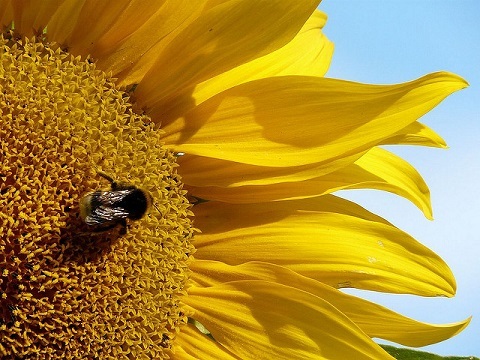How to lure pollinators with sunflowers

Sunflowers are rich sources of nectar and pollen for honeybees, bumblebees and other wild bee species, butterflies and other beneficial insects. (Credit: Nick Grapsy via Flickr)
Your garden is bee and butterfly-friendly. You've made a bee bath, a bumblebee house and count birds in your backyard. What's left?
I quizzed Mark from West Coast Seeds about the benefits of growing sunflowers!
All garden sunflowers are descended from the Central American Helianthus annuus.
Conventional plant breeding allows for selection of height, flower size and colour, and size or oil content of seeds. Russian mammoth and giganteus grow ten feet tall or more in a single season, with a stem more like a tree trunk. Each flower head "face" is actually individual florets tightly packed into a spiral pattern. Each pollinated floret produces a single sunflower seed. Really big sunflowers produce hundreds of seeds!
Which pollinators like sunflowers?
Sunflowers' height makes them beacons for pollinators, rich sources of nectar and pollen for honeybees, bumblebees and other wild bee species, butterflies and other beneficial insects.
Planting sunflowers in your food garden lures the most important insects and will improve pollination for a host of fruits and vegetables.
When should I plant sunflowers?
Wait until the ground warms up in the spring before sowing the seeds (West Coasters start planting in April and May). This will allow each plant to anchor roots in the soil.
Get kids involved! The seeds are big -- easy for tiny hands. Push each seed two centimetres (one inch) into the soil. Big varieties need to be spaced three to five feet apart, but tiny ones will grow one foot apart (or one plant per three-gallon container).
Note: Sunflowers started in containers sometimes have root growth interrupted and may not develop a sturdy anchor for staying upright in stormy weather.
How much space do I need?
Not all sunflowers are tall. Choose dwarf varieties, like music box (grows a few feet) for raised beds or in large containers, like half-barrels. For small spaces, choose tiny suntastic, which reaches about 30 centimetres (12 inches) tall, doesn't produce edible sunflower seeds, but adds colour to patio containers.
How will I know when to harvest sunflower seeds?
Seeds are ready to harvest when birds make frequent visits. Seeds from large sunflower species contain a substantial amount of oil -- much loved by chickadees!
Love birds? Leave the flower in the garden as a natural fall and winter bird feeder.
Where will you plant sunflowers?
Comment on this blog to win a package of sunflower seeds donated by West Coast Seeds. (Draw date: April 12, 2016)
Sincerely,
Lindsay Coulter, a fellow Queen of Green
Hey! Want more DSF? Join David Suzuki on Facebook

David Suzuki's Blog
- David Suzuki's profile
- 247 followers



